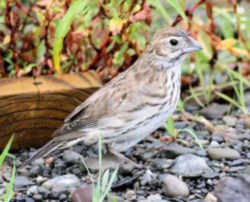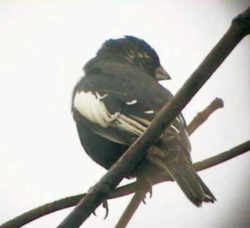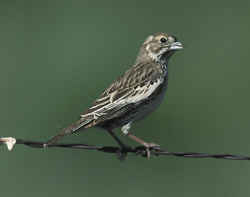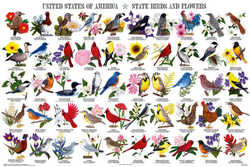Colorado State Bird
Lark Bunting - Large sparrow

(Calamospiza melancorys Stejneger)
Adopted on April 29, 1931.
The migratory Lark Bunting, (a large sparrow) (Calamospiza melanocoryus Stejneger,) was adopted as Colorado's official state bird by the Twenty-eighth Session of the General Assembly of the State of Colorado on on April 29, 1931. It was chosen because of its acrobatic courtship dance and melodic song. The Lark Bunting is a medium-sized sparrow. It is the only member of the genus Calamospiza (Bonaparte, 1838)
Colorado State Bird: Lark Bunting

The Lark Bunting, large sparrow, is a migrant bird. Flocks arrive in April and inhabit the plains regions and areas up to 8,000 feet in elevation. They fly south again in September. The male bird is black with snowy white wing patches and edgings, tail coverts and outer tail feathers. In winter the male bird changes to a gray brown like the female bird, however the chin remains black and the black belly feathers retain white edgings. The female bird is gray brown above and white below with dusky streaks. The male bird is six to seven inches while the female is slightly smaller. The male Lark Bunting is the only sparrow that completely changes plumage from distinctive breeding colors to plain winter ones. The male bird performs a spectacular courtship flight, during which he warbles and trills a distinctive mating song.
Characteristics of the Lark Bunting
- Small songbird; medium-sized sparrow.
- Short, thick, bluish bill.
- Large white patch in wings.
- Relatively short tail with white tips to feathers.
- Breeding male all black with white wings.
- Female and nonbreeding male grayish brown and heavily striped.
- Size: 14-18 cm (6-7 in)
- Wingspan: 28 cm (11 in)
- Weight: 30-51 g (1.06-1.8 ounces)
Habitat
Lark buntings make their home in the prairie and grassland regions of central and western North America. In summer, they live in meadows and sagebrush-covered areas. During the winter months they migrate in flocks to the desert regions of Texas and Arizona as well as northern Mexico.
Life Cycle

Lark buntings build their nests on the ground in grassy areas and under shrubs. The nests resemble an open cup with deep sides. They lay between 2 and 6 pale blue eggs at a time.
Sex Differences
Breeding male black with white wings, female dull gray and white striped.
-
Adult male alternate:
- Black plumage
- Large wing patch
-
Adult female:
- Brownish head with pale supercilium
- Brown streaked back
- White under-parts with heavy streaking
- Blackish wings with brown edges and white wing patch
- Basic and immature plumages similar to female
Colorado Revised Statutes
The law designating the lark bunting as the official Colorado state bird is Section 24-80-910 (Lark bunting) of the Colorado Revised Statutes, specifically Title 24 (GOVERNMENT - STATE - STATE HISTORY, ARCHIVES, AND EMBLEMS) Article 80 (STATE HISTORY, ARCHIVES, AND EMBLEMS) Part 9 (STATE EMBLEMS AND SYMBOLS) Section 24-80-910.
TITLE 24. GOVERNMENT - STATE.
ARTICLE 80. STATE HISTORY, ARCHIVES, AND EMBLEMS.
PART 9. STATE EMBLEMS AND SYMBOLS.
24-80-910. Lark bunting.
The lark bunting, scientifically known as calamospiza melancorys stejneger, is hereby made and declared to be the state bird of the state
of Colorado.
Source: L. 31: p. 735, S 1. CSA: C. 152, S 10. CRS 53: S 131-8-10. C.R.S. 1963: S 131-8-10.
Taxonomic Hierarchy: Lark Bunting
Kingdom: Animalia (animal)
Phylum: Chordata (animals with a backbone)
Class: Aves (bird)
Order: Passeriformes (perching birds)
Family: Emberizidae (emberized finches, American sparrows, towhees, buntings)
Genus: Calamospiza Bonaparte, 1838
Species: Calamospiza melanocorys Stejneger
Binomial Name: Calamospiza melanocorys Stejneger
Taxonomic Serial Number: 179312








